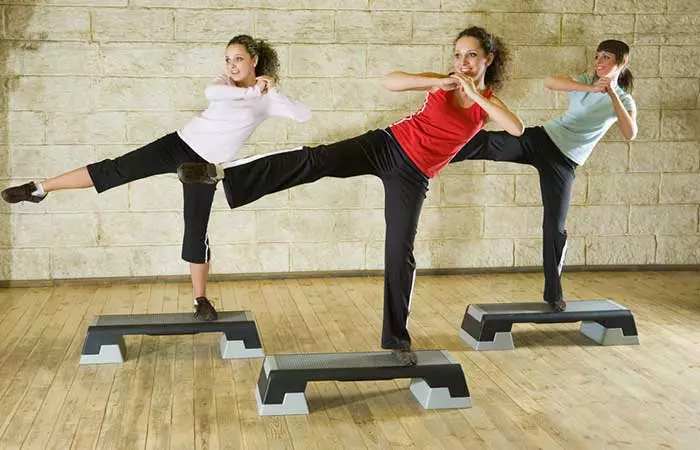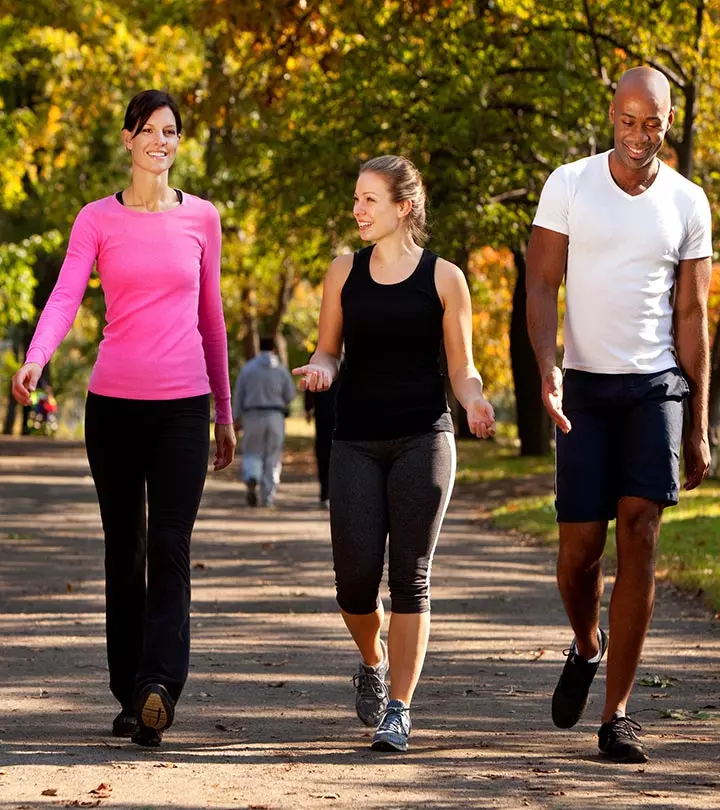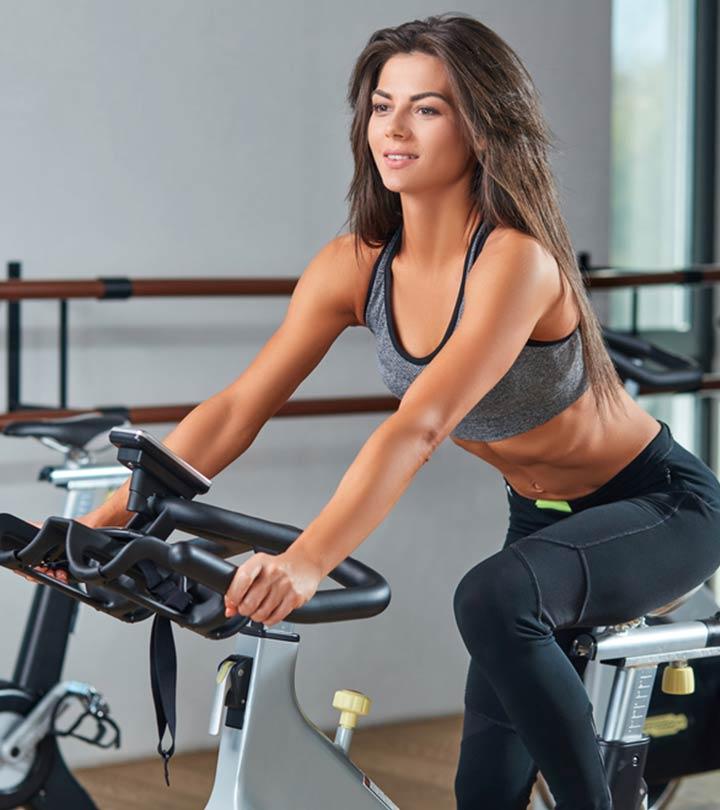10 Exercises To Increase Lung Capacity – Steps To Follow
It's time to make shortness of breath while exercising a thing of the past!

Image: shutter stock
Did you know that even your lungs need exercise to stay healthy and for your body to function normally? Your body needs oxygen for survival. Every activity in the body is dependent on oxygen, including the metabolic functioning of cells. The lungs perform the task of delivering oxygen to every part of the body. And, by practicing a few exercises regularly, you can train your lungs to increase their capacity, which will lead to improved lung efficiency and better oxygen intake. This will, in turn, protect the body from various breathing disorders, help increase stamina, and ensure improved oxygen supply to every part of the body. So, scroll right down and check out these super-efficient exercises to increase your lung capacity while you experience an improved quality of life.
 Workout Blueprint: Exercises To Increase Lung Capacity
Workout Blueprint: Exercises To Increase Lung Capacity- Frequency: Daily
- Benefits: Increase stamina, improve oxygen supply, and reduce shortness of breath.
- Equipment Needed: Exercise mat, step platform, workout shoes.
- Space Required: Large area
- Assistance Required: No
- Who Should Avoid: Anyone with acute respiratory or severe heart conditions.
In This Article
Exercises To Increase Lung Capacity
Warm Up
A warm up is necessary before doing any exercise.So, let’s warm up before starting the exercises to increase lung capacity.
- Head Tilt (left and right) – 1 set of 10 reps
- Head Nod (up and down) – 1 set of 10 reps
- Neck stretch
- Arm circles – 1 set of 10 reps
- Shoulder circles – 1 set of 10 reps
- Waist circles – 1 set of 10 reps
- Bend over and touch toes – 1 set of 5 reps
- Calf raise – 1 set of 20 reps
- Interlock your fingers, extend your hands forward and pull your shoulders back.
- Slow spot jogging – 1 set of 20 reps
Now you are set and can start the lung exercises. Here’s what you must do.
1. Abdominal Breathing
Incorporating deep breathing exercises into your routine can also aid in better lung function and relaxation. Abdominal breathing is an excellent exercise when it comes to increasing the lung capacity.
Here’s a step by step explanation. You can also click on the video link to watch how to do abdominal breathing exercise correctly.
Steps To Do Abdominal Breathing
- Lie down on your back with one hand on the abdomen and the other on the chest.
- You can place a pillow underneath your knees.
- Breathe in through the nose, hold your breath, and exhale through the mouth.
- Try and squeeze your abdominal muscles in the end to remove any residual air from your lungs.
- Do this 10 times and then come to a seated position.
- Relax your shoulders, keep your back straight, and practice abdominal breathing techniques.
Duration
5 minutes every day.
2. Rib Stretch
This exercise is all about breathing through the lungs so that your ribs expand and contract as you inhale and exhale
. This also trains your lungs to inhale the maximum amount of oxygen. There’s a step by step description of how you stretch your ribs, but you can also watch this video.
Steps To Do Rib Stretching Exercise
- In the rib stretch, you have to stand upright, with your back erect, and exhale all the oxygen from your lungs.
- Breathe in slowly and hold as much air in your lungs as you can.
- Hold your breath for 10 to 15 seconds before exhaling slowly.
- Do this exercise three times a day to improve lung capacity.
- Place your hands on your waist and bend on each side alternately.
- Bring your hands overhead. Bring the left hand back to your left waist and bend towards your left to feel the stretch on your right side.
- Do the same on the other side. Repeat this a few times.
- Finish with a few more rib stretch breaths.
Duration
2-5 minutes every day.
3. Numbered Breath
This exercise will help you if you are suffering from COPD (Chronic Obstructive Pulmonary Disease) or just want to increase your lung efficiency and capacity.
Following are a video and a step by step description of this highly effective breathing exercise.
Steps To Do Numbered Breathing Exercise
- Stand straight with your feet shoulder-width apart.
- Breathe in through your nose for 2 seconds and while breathing out, purse your lips and exhale for 4 seconds.
- Add a little variation to this exercise by clasping your hands together and extending your arms in front of your chest.
- Breathe in through your nose, and while breathing out, twist towards your left and then to your right. Do this for as long as you exhale. Make sure the duration of exhalation is longer than that of inhalation.
- Another variation is to flex your elbows and put your fingers on your shoulders (like a chicken) and inhale. While exhaling, do a set of arm circles.
- Now, do abdominal breathing for 1 minute.
- Finally, end it with forceful breathing.
Duration
5 minutes every day.
4. Oriental Breath
Oriental breath is yet another breathing exercise that helps the lungs work efficiently and optimally.
It can also help you lose weight. Here’s a video demonstrating it.
Steps To Do Oriental Breath Exercise
- Stand with your right leg in front of your left leg.
- Squeeze your glutes, lean slightly backward, and keep your shoulders relaxed.
- Inhale in 3 seconds. You can move your arms from your sides to over your head as you inhale.
- Pause for a moment and then exhale suddenly with force. Move your hands from over your head to the sides as you exhale.
- Repeat this 3-5 times.
Duration
2 minutes every day.
5. Pushing Out
Pushing out is a super powerful breathing exercise that increases the capacity of your lungs to absorb oxygen. Here are a video and a step by step description of how to do it correctly.
Steps To Do Pushing Out Exercise
- Stand in an upright posture and loosen your knees.
- Bend down as you push out all the air from your lungs.
- Get back to the standing position, breathing in the air.
- Fill your lungs with as much air as possible and hold your breath as long as you can.
- Extend your arm over your head and lower back to the starting position while exhaling. Do this exercise 4 times daily.
Duration
1 minute every day.
6. Lung Strengthening Pranayama
Anulom-vilom is a pranayama that can help improve your lung capacity. It also helps with stress reduction and provides relief from anxiety. Doing it correctly can be challenging in the beginning, but practice will make you perfect. Here’s a video to guide you.
Steps To Do Anulom Vilom
- Sit in the Lotus Position. Keep your back straight and core engaged.
- Close your left nostril with the ring finger of your left hand.
- Take a deep and slow breath through your right nostril.
- Now, close your right nostril with your thumb and simultaneously open your left nostril by moving your ring finger away.
- Slowly exhale through your left nostril.
- Take a deep and slow breath from your left nostril.
- Again, close your left nostril with the ring finger and simultaneously open the right nostril by moving your thumb away. Slowly exhale.
- Do this 10 times.
Time
5-7 minutes every day.
7. Aerobics

Understanding the differences between yoga and aerobic exercises can also help you choose the right type of exercise for your needs. Both have their own benefits, with yoga focusing on flexibility and breathing, while aerobic exercises are great for cardiovascular health. Aerobic exercises play a significant role in lung capacity training by making large muscle groups move at a rhythmic speed (1). They strengthen your heart and lungs and also play a role in improving the endurance of the body. Hence, respiratory muscle strengthening will lead to the use of oxygen more efficiently, and it also can enhance your breathing. You should take long, brisk walks daily. Stationary biking is another type of aerobic exercise that helps improve lung capacity.
Duration
20 minutes every day.
8. Water-Based Exercises

Water workouts make your body work harder because water acts as a source of resistance. This helps in strengthening the lungs. You may do weight lifting and stretching exercises in water. A person needs to have a routine till she gets comfortable with exercising in water.
Ensure the water is neck deep while exercising. It is important to take quick breaths because you would feel the compression of your body. With regular practice, this will help in tremendously increasing the efficiency of lungs.
Duration
20 minutes every day
9. Cardio Exercise

The lung capacity increases manifold with cardio exercises. One needs a minimum of 30 minutes of workout to remain fit. The basic principle lies in the fact that when a person gets tired doing a fast and brisk workout, his lungs have to work harder. This enhances their capacity.
There are many exercises you can do with ease to build cardiovascular endurance. Some of the best cardio exercises to expand lung capacity are running, jogging, and swimming. You can even hit the gym to work out on heavy machines. Just make sure you warm up and cool down before and after the workout.
Duration
20 minutes every day.
10. Workout At High Elevation

The oxygen content at high altitudes is less, and hence, your lung capacity greatly increases if you workout in such altitudes. You need to start slow as it is tough to exercise at higher elevations. You need to give your body at least two weeks to acclimatize to the altitude. Ensure you take assistance from a qualified instructor as unsupervised workout could increase the chances of altitude sickness. Exploring how to increase oxygen levels in the blood through lifestyle changes and specific breathing exercises can be quite effective.
Duration
20 minutes every day.
These were the 10 lung capacity increasing exercises. You can also improve your lung capacity by trying breathwork exercises like increasing your inhalations and exhalations. Jennifer Le, a blogger, practices breathwork, a form of lung exercise. She writes, ” If you feel that therapy and other ways are not working, I do recommend giving this holistic approach of breathwork a try and see how it helps you heal from within (i)”. Practicing breathwork regularly is said to improve your mental and physical health.
Keep reading to learn a few tips that can help you as you perform these exercises.
Tips

- Ensure your breath is steady and slow every time you do any breathing exercise. While exhaling, your lungs should be emptied completely.
- Always sit upright while performing breathing exercises.
- Exercise regularly.
- You can also learn to play a wind instrument to increase your lung capacity.
- If the wind instrument is not your thing, you can learn to sing or join a choir group to increase your lung capacity.
- If you splash some water on your face while doing breathing exercises, it will increase your heart rate, and the movement of oxygen throughout the body will become easier.
- Take necessary precautions while holding your breath. Learn to relax your muscles, especially while doing breathing exercises.
- Adjust your body to the surroundings and temperature. This is also known as acclimatizing the body.
- Start with small sets and slowly increase the duration of the exercise.
- Consume antioxidant-rich foods.
- Always follow safety precautions, especially during water exercises.
 Quick Tip
Quick TipWarnings And Precautions
- Stop smoking or being around smokers.
- Do not overexert your body.
- Practice proper techniques to breathe in and breathe out.
Many people feel they do not need to increase their lung capacity until the time a simple and short exercise like playing with their kids or running with pets tires them and leaves them breathless. They can now do these exercises to increase their lung capacity and enjoy their leisure time with their loved ones without experiencing shortness of breath and fatigue.
 Did You Know?
Did You Know?Infographic: Top 4 Exercises To Boost Your Lung Capacity
Increasing your lung capacity can be helpful for your overall respiratory health. You can train your lungs through certain exercises and strengthen the diaphragm muscles so that you breathe more efficiently. This is especially helpful for those with respiratory issues and who struggle with shortness of breath. The infographic below covers the 4 easiest and most effective exercises to boost your lung capacity. Check it out.

Illustration: StyleCraze Design Team
The healthier your lungs, the more oxygen your body inhales. So, you must include certain exercises for improved physical performance due to an increase in lung capacity. The exercises listed above are simple and work well to keep respiratory diseases and other anomalies in check to maintain respiratory health. However, do not forget to warm up your body before doing these exercises. Always maintain an upright sitting posture while doing some of these exercises, and it is important to empty your lungs completely while exhaling. Start with a small number of sets and gradually increase them so that you do not burden your lungs suddenly. These exercises will help with asthma management, chronic bronchitis management, pulmonary fibrosis management, etc., and might prove to be the most effective when compared to constantly depending on the medication.
Frequently Asked Questions
What decreases lung capacity?
Age may decrease lung capacity. Additionally, obstructive lung diseases like chronic obstructive pulmonary disease (COPD) and obesity are some causes of reduced lung capacity (2) and faulty pulmonary function.
What does 50% lung capacity mean?
Since 80%-120% is usually considered the standard lung capacity, anything outside this range may be regarded as an obstructive or restrictive lung condition. Therefore, 50% lung capacity may not be healthy.
What is the 4-7-8 breathing technique?
The 4-7-8 breathing technique is a breathing pattern that may help reduce anxiety and improve quality of life (3). Anecdotal evidence suggests that it may even help increase lung capacity. For this technique, breathe in for four seconds. Then, hold your breath for seven seconds, followed by slowly breathing out for eight seconds.
Can poor posture or incorrect breathing techniques contribute to poor lung capacity?
Yes, quite possibly, they can. A study on volunteers from Daegu University, South Korea, found that poor posture while using a smartphone led to reduced respiratory function (4). While no relevant studies prove incorrect breathing techniques may decrease lung capacity, anecdotal evidence suggests that they may lead to headaches, respiratory problems, and other chronic issues.
Key Takeaways
- Cardiovascular workouts like running and swimming improve lung capacity and blood circulation.
- Resistance training such as weight lifting and bodyweight exercises build endurance.
- Slow and deep breathing exercises improve nervous and cardiovascular health and may increase lung capacity.
Illustration: Exercises To Increase Lung Capacity - Steps To Follow

Image: Dall·E/StyleCraze Design Team
Increase your lung capacity with simple exercises in this informative video. Enhance your respiratory health and improve your overall well-being. Watch now and take charge of your lung health.
Personal Experience: Source
StyleCraze's articles are interwoven with authentic personal narratives that provide depth and resonance to our content. Below are the sources of the personal accounts referenced in this article.
i. How Breathwork Transformed My Life and Healed My Relationshipshttps://intentjen.medium.com/how-breathwork-transformed-my-life-and-healed-my-relationships-52c49174a8fe
References
Articles on StyleCraze are backed by verified information from peer-reviewed and academic research papers, reputed organizations, research institutions, and medical associations to ensure accuracy and relevance. Read our editorial policy to learn more.
- Role of increasing the aerobic capacity on improving the function of immune and respiratory systems in patients with coronavirus (COVID-19): A review
https://www.ncbi.nlm.nih.gov/pmc/articles/PMC7186129/
- Physiology Lung Capacity
https://www.ncbi.nlm.nih.gov/books/NBK541029/ - The Effect of Deep Breathing Exercise and 4-7-8 Breathing Techniques Applied to Patients After Bariatric Surgery on Anxiety and Quality of Life
https://pubmed.ncbi.nlm.nih.gov/36480101/ - Effect of sitting posture on respiratory function while using a smartphone
https://www.ncbi.nlm.nih.gov/pmc/articles/PMC4905897/
Read full bio of Randall Holmes
Read full bio of Charushila Biswas
Read full bio of Ravi Teja Tadimalla
Read full bio of Payal Karnik


























Community Experiences
Join the conversation and become a part of our empowering community! Share your stories, experiences, and insights to connect with other beauty, lifestyle, and health enthusiasts.